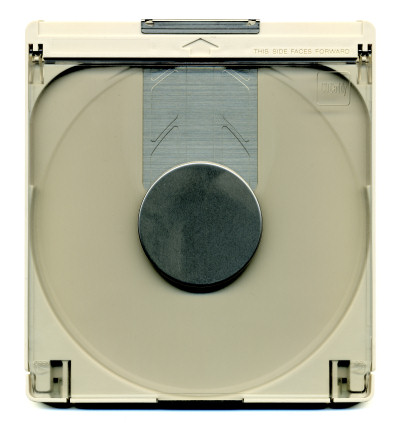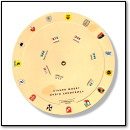[ Retro Scan of the Week ] The CD-ROM Caddy
January 30th, 2012 by Benj EdwardsHere’s a computer artifact you don’t see very often these days: a CD caddy. Many early CD-ROM drives (released roughly 1985 – 1993) required the use of CD caddies, which were designed to protect CD-ROM discs from dust and rough handling. With a CD inside, they look a lot like a bigger version of a 3.5″ floppy disk, albeit with a clear window on one side.
When I ran across this caddy in my collection recently, it made me think a little deeper about why engineers invented them in the first place. Why were CD caddies so common at one point, I wondered, and why are they virtually extinct today?
I have decided that it all boils down to the price and preciousness of commercial CD-ROM discs.
The Land Before CD Burners
When manufacturers first introduced CD-ROM drives in the mid-1980s, CD-ROM titles were very expensive and nearly impossible to copy.
The earliest discs typically held the equivalent of dozens of volumes of printed books, such as an encyclopedia or a comprehensive medical reference. At that time, printed references were still big business, and publishers didn’t want to cannibalize print sales with a relatively cheap, easy to produce, and easy to distribute computer data disc. That factor, when combined with low competition and low demand, kept CD-ROM prices high. For example, a copy of the all-text (this is pre-multimedia) Grolier’s Academic American Encyclopedia on a single CD-ROM sold for $199 in 1986 (that’s $360.99 when adjusted for inflation).
If you bought a $361 CD-ROM disc today, and you had no way to back it up, copy it, or download the equivalent data from the Internet, you’d probably want to put it in a CD caddy too.
Compare that price with the average music CD, which cost about $15 in 1986 (about $30.79 in today’s dollars). If you scratched your Bruce Springsteen CD, it wasn’t that much of a financial outlay to replace it, which would explain the lack of caddies in music CD players.
The Demise of the CD Caddy
The CD caddy carried with it two major drawbacks that led to its downfall: cost and inconvenience. To protect all your CD-ROM discs, as intended, you had to buy a caddy for each disc, which added significant ownership cost at a time when caddies sold for over $10 a piece. Exactly because of this, people tended to buy only a few CD caddies and swap their discs out between them. Inserting and removing a disc from a caddy was a tedious operation that actually increased disc handling time, thus negating the protective benefits of the caddy to begin with.
As CD-ROM titles began to drop to the under $100-per-disc mark (very early 1990s), tray-loading CD-ROM drives emerged that did not require caddies. They were convenient and easy to use. When paired with continually dropping CD-ROM disc prices, caddy-using drives became rare by the mid-1990s, and almost completely extinct by the time CD burners went mainstream in the late 1990s. By that time, the preciousness of your average factory-pressed CD-ROM disc had dropped dramatically.
Not all CD-ROM and optical media titles are cheaper today than they were in the past. After all, Adobe Photoshop on DVD-ROM costs over $1,000. But the Photoshop disc itself doesn’t mean that much when you can rip it in a few minutes to a hard disk, dupe it to a blank DVD, or find the program online if necessary. The program doesn’t even run off the disc as most CD-ROM titles once did, so we just install the program to a hard drive and set the disc aside.
Another Reason for the CD Caddy?
While CD-ROM disc prices most likely explain the rise and fall of CD caddies, they may not tell the complete story. There could be legal (say, patent) or mechanical reasons why manufacturers went with caddy-load over tray-load techniques in early CD-ROM drives, although I have no evidence to support those theories at present. (One of the earliest CD-ROM drives used a top loading paradigm, by the way.)
For example, perhaps early CD-ROM drives could be made smaller or more cheaply if they used caddy-load mechanisms. Or maybe the caddies allowed early drives to read discs faster than 1X speed. To find out, we’d have to talk to an engineer who designed CD-ROM drives, and that’s a bit beyond the scope of a Retro Scan of the Week.
If anyone out there designed or worked on CD-ROM drives professionally, I would love to hear from you in the comments below.
Discussion Topic of the Week: When did you get your first CD-ROM drive (for a personal computer)? What were some of the first CD-ROM titles you owned?







January 30th, 2012 at 7:33 pm
An interesting article. I always wondered about CD-ROM caddies and why they were invented. Thanks for clearing that up.
As for my first CD-ROM drive, that came with my first IBM compatible system, which was a *shudder* Packard-Bell.. This was back in late 1993-early 1994. The first software I had was, naturally, the programs which came with the computer. Groiler’s Encyclopedia, 3D Human Body, 3D Dinosaur Adventure, MegaRace, and a few others.
January 30th, 2012 at 8:13 pm
I remember being told by a few knowledgeable friends that in the early days, caddies did indeed allow faster read speeds than trays.
Of course, this was strictly friend-of-a-friend-of-a-friend-of-an-expert stuff, so I can’t confirm whether or not it’s true. Merely that, at a minimum, that was circulating as a fact (true or not) at some point.
January 30th, 2012 at 10:43 pm
“Inserting and removing a disc from a caddy was a tedious and risky operation”
Um, did you have some kind of weird caddy system that involved tweezers, spikes and barb wire? The caddies I had were about as tedious and risky as a removing and replacing a disc on a top-loading Sega CD.
As I remember it, caddies weren’t really meant to be for all of your discs, but more practically for whatever you were using at the time. I think part of it was that people still had vinyl fears- as if caddy drives would do less damage to your discs that putting it in a normal drive. I seem to remember for the longest time that some very-vocal-but-very-wrong folks believed that both the disc spinning on plastic and the optical lasers burnt damage into discs much like needles did on vinyl. With the way caddies worked from a mechanical perspective, I’m certain that they had a better initial reputation to that end.
January 30th, 2012 at 10:57 pm
my first cdrom drive was a Sony CDU33A, double speed drive. can’t remember the year though. i attached it to my Sound Commander SoundCard within 486DX2-66 PC. if i remember correctly, some of the very first Multimedia Titles i got was a CD with Three Stooges videos and Bugs Bunny. and of course, MYST!!
January 31st, 2012 at 1:04 am
I got my first CD-ROM drive at the beginning of 1995. It was a Sony double-speed drive with a proprietary Sony interface. I bought the Tex Murphy “Under A Killing Moon” adventure game at the same time.
Now this was an internal drive. Around the same time, a friend of mine was determined to be much more high end. He bought an external SCSI CD-ROM drive. And, yep, it was caddy-loaded. He was awfully proud of his SCSI-equipped PC in 1995.
January 31st, 2012 at 7:47 am
“Um, did you have some kind of weird caddy system that involved tweezers, spikes and barb wire? The caddies I had were about as tedious and risky as a removing and replacing a disc on a top-loading Sega CD.”
Heh, no, but I was trying to imply that the caddies were not designed for repeated opening and closing many times over, so swapping discs increased your chances of both scratching your CD while inserting/removing it, and breaking your caddy by wearing it out. The caddies I have are definitely clumsy to open and close, and you’d need four hands to swap a CD from it quickly.
January 31st, 2012 at 9:43 am
These were pretty useless as I remember, about as useless as the “longbox” that all music came in for several years.
Does anyone remember CED players? It was a video record that came in a big plastic record caddy.
January 31st, 2012 at 1:15 pm
My first caddy came in the CDTV, the Amiga with built in CD-Rom. Never found too many titles made for it, though. At the time I worked at an Amiga retailer in Redondo Beach, and fell for my own sales pitch! I loved the Amiga and still thought the CDTV was a great idea, but it was a bit premature market-wise. I loved that you could put a music CD in, and it would play it back with a really slick on-screen interface that showed a rendering of a spinning CD with a laser and head shooting it and moving it when you changed tracks.
January 31st, 2012 at 4:16 pm
I got a CD ROM on my 286 (pictured in the forums). That thing ran like a ket engine!!! The first CD ROM software that I had for this machine was Sam and Max Hit the Road. Such an amazing, entertaining game. LOVE IT!
February 1st, 2012 at 2:00 am
Professional CD players (the kind that radio stations use) often still use these. In that kind of environment, they allow quicker insertion and removal of the disk and they do prevent damage.
February 2nd, 2012 at 10:30 am
I read the original specifications on these back in the mid-nineties. The original ISO 9660 Standard required a protective casing, in much the same fashion that a magnetic disc required a protective casing.
The though behind it was that these disc where dual layered and meant for long term data archiving. There for simple slot loading was the easiest way to design these. But the caddies had a draw back, yes they could read and operate faster than the tray loaders but they where limited on the speed they could go to. I had a 4x caddie drive in my Pentium tower which I loved over the tray loaders but it would scratch up the discs after continuous usage even without removing the cd it still would scratch over time. After reading through an article by PC Mag that pointed out how cd was spinning to fast for the caddy and causing drag would catch on internal parts and scratch.
So in reality the caddie loaded CD died not only because of cost as you pointed out but because of its own limitations. Much in the same matter as DVD data killed the CD.
February 20th, 2012 at 8:08 pm
I have a bunch of these caddies. I specialize in converting old disks to modern disks, and some of the older disks don’t work right until I stick them in my 1x CD-ROM drive.
I also have a couple of very thin caddies that were used with the first generation of DEC (Digital Equipment Corporation) CD-ROM drives. I don’t have the drive, but have the caddies.
I also remember the CED disks — had two titles, but they were too expensive. The format died when the publisher discovered that the lubricant needed was mixed up by 2 guys in a garage…
March 9th, 2012 at 8:44 pm
http://en.wikipedia.org/wiki/Phase-change_Dual
If you had a PD drive and wanted to use your CD in your PD drive you would have to place the CD in a cady. That is one resson why the cadys existed for CD-ROM disks. I think that the CD-ROM cady died out with the PD drive, since I don’t see PD drives anymore. I have seen some PD drives that also have groves for mounting non-cadyed CD’s. There are also M.O. Disks (Magneto Optical Disk) that use cadys. These disks hold a lot, 9.1GB!
http://di1-3.shoppingshadow.com/images/pi/bb/6d/e6/21054622-260×260-0-0_Sony+Sony+Rewritable+Magneto+Optical+Disks+9+1GB+1.jpg
I see Magneto Optical Disks all the time. (well I work on MRI and CT scanners that use them for storing pacient data.) So I don’t think that the cd cady is exstink, not until flash drives come down in price.
March 10th, 2012 at 12:48 pm
Calvin,
PD Drives didn’t exist until 1995, which was about ten years after the advent of CD-ROM drives with disc caddies.
May 31st, 2012 at 8:12 pm
I worked for a company that published a CD database around 1991. The Toshiba 3401B 2x SCSI CD drive was the best at that time. It used a caddy because
– it allowed for more insertions/removals than a tray mechanism, perhaps 3-4x as much
– the drive’s side of the mechanism was a lot simpler and more reliable
The drive data sheets clearly list # of tray operations.
The CD database required many drives and was still slow, so high end customers merely copied the CD to a Novell Netwear server with striped disks.
The re-writeable optical media required caddies for the write protect tab!
July 12th, 2012 at 2:06 pm
I remember the CD-ROM caddy very well, through the AppleCD 300 external drive that came with the LC475. It was the second computer I ever owned (it replaced an Apple IIGS that I got for Christmas one year), and I remember how brilliant I thought the caddy concept was at the time. It’s funny how quaint it seems now. I still have both the computer and drive, and they still function.
October 19th, 2016 at 4:07 am
My first CD-ROM drive was the Mitsumi 1x one where the entire drive mechanism slid out then a clamshell top cover lifted up to insert or remove the disc.
It was made well before the advent of burnable discs, but amazingly it would read the ones with the dark green or blue dye, which don’t seem to be made anymore.
I saw one car stereo that used caddies. For a car they’d be pretty good. Discs always protected, won’t get scratched if they get dropped on the floor along with the dirt, sand and other debris.
April 7th, 2017 at 8:55 am
I remember having a caddy loading cd burner as a kid, I remember people calling burners “toasters”
June 22nd, 2017 at 10:17 pm
I spec’d out caddy drives for our two mammoth system builds in the 1990s. One was the NEC SCSI caddy model that was the fastest at the time, and the second system had a SCSI Yamaha 4x/4x CD-R which for many years was the fastest CD-R drive on the market. We paired that with a Plextor SCSI CD-ROM drive.
These drives were virtually silent compared to today’s tray-based drives. The caddys also seemed to allow the interior of the drive to stay more dust-free, which I recall was a potential issue back in the early days of optical drives.
I really liked the caddys. They never got stuck, or jammed, or didn’t come out or any other such non-sense on today’s $20 drives. But the $20 drives are what made data easy to share, so that was the tradeoff.
I still have all the above mentioned drives as well as the computers they were installed into. It’s amazing to see a DOS based system transfer over 10MB/sec on a CPU running at under 166Mhz. Makes you really wonder what we’ve gained with 20x increases in CPU and RAM speeds…
July 21st, 2022 at 6:58 pm
I’ve got several dozen of those Sony caddies. Some still in their cellophane wrap. Seems a pity to throw them out. Does anybody want them? Free except for postage from Sydney Australia.
Some of the CD-ROMs may be of interest, Such as a full set of the NASA Voyager pics. Also the Canadian OH&S disks.